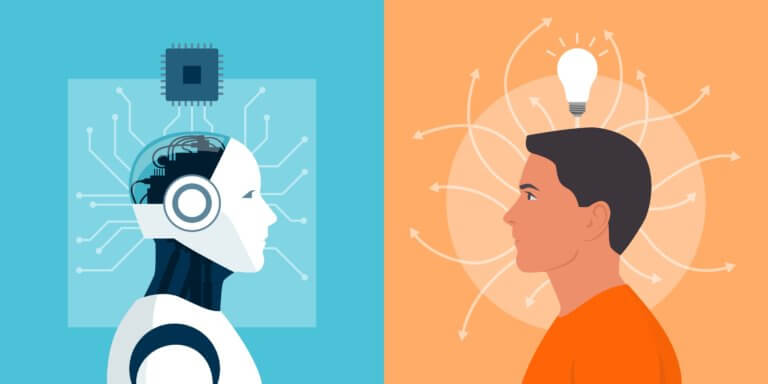Artificial intelligence (AI) has become a transformative force in various industries, and its impact on customer experience (CX) design is undeniable. AI starts to affect our work and daily lives, giving us answers, helping us with complex tasks, and lowering risks. With AI-powered solutions, the promise is that businesses can revolutionize customer interactions, engagement, and the overall experience. They help redefine how businesses connect with their customers.
However, despite its promises, many people are unsure if AI is truly valuable or relevant. They question whether brands should quickly adopt this new technology, or wait to see its worth and impact. For all of the hype, exploring the benefits and challenges of applying AI in CX design is important. A balanced view can bring greater clarity to the role of AI.

Image Source: Shutterstock
THE BENEFITS
Leveraging AI-powered technologies, companies can gain valuable insights, automate processes, and deliver personalized experiences that drive customer loyalty. One of the key benefits of AI’s predictive analytics is its ability to enhance customer touchpoints. By understanding customer behavior, businesses can optimize various touchpoints in the customer journey to deliver a more seamless and satisfying experience.
Companies can analyze user behavior on their website to find areas for improvement. They can then make changes to improve navigation, load times, and provide personalized content. We have identified three key benefits of AI-enabled customer experience:
1. Faster Response Time: Streamlining Customer Interactions
In today’s fast-paced digital world, customers expect prompt and efficient services. Whether it’s a query, concern, or request, customers want their issues addressed quickly, without unnecessary delays. AI enables businesses to shorten their response time and enhance CX like never before.
One of the most prominent examples is using AI-powered chatbots and virtual assistants. These intelligent chatbots can quickly respond to customer queries, ensuring round-the-clock availability and support. By automating repetitive tasks, AI-powered chatbots not only improve customer satisfaction but also reduce the workload of human agents, allowing them to focus on more complex issues.
2. Increased Personalization
Another area AI significantly impacts is the delivery of relevant and personalized content. By monitoring user behavior, AI algorithms can suggest tailored content and product recommendations that align with the customers’ interests and preferences. This customized approach increases customer engagement and enhances the chances of conversion and repeat purchases. Whether it’s recommending similar products, suggesting related articles, or offering personalized discounts, AI empowers businesses to deliver unique customer experiences.

Image Source: Shutterstock
3. Problem Resolutions Enabled by Sentiment Analysis
Furthermore, AI-powered analytics plays a vital role in understanding customer sentiment and expectations. AI can analyze customer feedback, social media posts, and other data. It provides businesses with valuable insights into customer sentiments. This helps businesses meet customer expectations. Sentiment analysis allows companies to identify potential issues or areas of improvement, and then improve their CX strategies in the long run.
THE CHALLENGES
However, businesses must strike the right balance between automation and human interaction in CX design. While AI-powered tools excel at automating routine tasks and providing quick responses, human intervention is necessary for some situations. Complex issues or sensitive matters often require empathy, understanding, and problem-solving skills from human agents.
Building customer trust and establishing emotional connections often need a human touch that AI cannot replicate. Therefore, businesses should consider leveraging AI to support human agents rather than replacing them entirely. They should understand the following:
1. Humanizing Knowledge and Service
AI algorithms can identify potential trends, preferences, and changes in customer expectations by analyzing user behavior patterns. This foresight enables businesses to proactively adapt their strategies, products, and services, staying one step ahead of evolving customer needs.
Yet, it’s crucial to maintain a balance between automation and human interaction. While chatbots and AI-powered virtual assistants can handle routine queries and provide quick responses, human agents should be available to address more complex issues or provide empathetic support when needed. Finding the right balance ensures a seamless CX that blends the efficiency of AI with the warmth of human interaction.
As AI constantly advances, businesses must stay updated with the latest developments to reap the full benefits. This may require investment in AI-enabled analytics tools, training employees on new technologies, and restructuring business processes to accommodate AI-driven CX design.

Image Source: Shutterstock
2. Ensuring Unbiased Guardrails
AI-powered CX design needs to consider diversity and inclusivity. AI algorithms should be impartial and avoid bias based on race, gender, or socioeconomic background. Training AI systems to recognize and prevent biases can be complex, but creating positive and fair customer experiences is essential. However, most AI learning models are programmed by humans with the unemotional impact of biases, as witnessed in the use of these technologies in policing and security.
In addition, the accuracy or relevancy of AI algorithms is one of the potential challenges. AI-powered solutions heavily rely on algorithms to analyze customer behavior, sentiment, and preferences. However, if the algorithms are not fine-tuned or regularly updated, they might generate irrelevant or inaccurate insights that can harm the customer experience.
3. One Size Does Not Fit All
Lastly, there is the challenge of customer acceptance and trust. Some customers may be hesitant or skeptical about interacting with AI-powered solutions, fearing a lack of personalized assistance or privacy breaches. Businesses need to communicate the values and benefits of AI in CX design while providing options for customers to choose human interaction if preferred. Building trust through transparent communication and delivering positive experiences are crucial.
DESIGNING A SUCCESSFUL AI-ENABLED CX STRATEGY
When designing a successful CX strategy, one of the first steps is to research your business model and goals. Understanding your business model is crucial because it forms the foundation of your CX design. It defines how your company creates, delivers, and captures value from your products or services.

Image Source: Shutterstock
Step One: Define the business model
To research your business model, you can start by reviewing your current operations and identifying your target market. Gain a deep understanding of your customers’ needs, preferences, and pain points. This will help you align your CX strategy with their expectations and create an experience that resonates with them.
Step Two: Confirm the business goals
Next, could you determine your business goals? What would you like to do with your CX design? Do you want to increase customer satisfaction, improve loyalty, or drive revenue growth? Clearly defining your goals will guide your decision-making process and help you measure the success of your CX initiatives.
Step Three: Market benchmark analysis
Once you clearly understand your business model and goals, it’s time to conduct market research. This involves gathering data on your industry, competitors, and market trends. Look for opportunities to differentiate your CX from your competitors and identify gaps or areas for improvement in the current market landscape.
Step Four: Consumer and employee analysis
Leverage customer and employee feedback and insights to inform your CX design. Collect feedback from customer surveys, online reviews, and social media interactions to understand your customers’ experiences and pain points. This data will provide valuable insights into what is and isn’t working well in your current CX and guide your decision-making process.
Incorporating customer and employee feedback into your research allows you to identify areas where your business model and goals align with customer expectations and where improvements can be made. It will also help you identify gaps in your CX strategy and refine it to deliver a more tailored and satisfying experience.

Image Source: Shutterstock
IN A NUTSHELL
AI profoundly impacts CX design, transforming how businesses interact with customers at every touchpoint. From AI-powered chatbots to predictive personalization and sentiment analysis, AI technology has the potential to revolutionize the CX landscape. Businesses can create positive experiences that drive customer satisfaction, loyalty, and success by leveraging AI to deliver personalized assistance, relevant content, and valuable insights.
In addition, researching your business model and goals is essential in designing an effective CX strategy. It ensures that your CX efforts are aligned with your business objectives and customer expectations. By understanding your target market, industry trends, and customer feedback, you can create a personalized and seamless experience that drives customer loyalty and business success. Finally, by balancing automation and human interaction, businesses can create exceptional CX that differentiates them in the market and foster long-term customer relationships.

